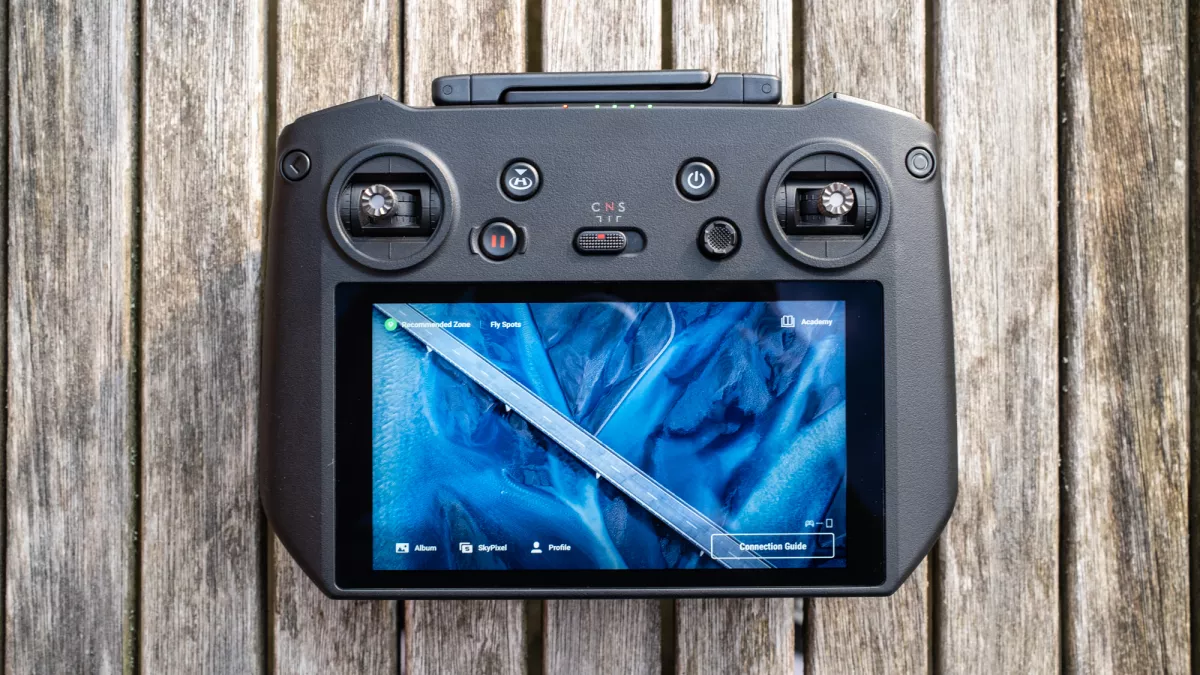The DJI Mavic 3 Pro is the world’s first consumer drone featuring three cameras and provides a highly versatile option that comfortably straddles the consumer and prosumer mar
DJI Mavic 3 Pro shown from above.(Image credit: James Abbott)


- Excellent build quality & folding design
- Large 3 camera gimbal
- 2 smart controller options
Unmistakably a Mavic 3 series model, the Mavic 3 Pro features the signature Mavic folding design and looks almost identical to previous models. The only significant giveaway, apart from the name badge, is the larger gimbal that’s home to the three cameras with the two telephotos sitting above the main camera. Folded, the drone is 9.10 x 3.85 x 3.75 inches (231.1 x 98 x 95.4 mm) which extends to 13.68 x 11.44 x 4.24 (347.5 x 290.8 x 107.7 mm) unfolded.
DJI Mavic 3 Pro shown from above.(Image credit: James Abbott)

- Excellent build quality & folding design
- Large 3 camera gimbal
- 2 smart controller options
Unmistakably a Mavic 3 series model, the Mavic 3 Pro features the signature Mavic folding design and looks almost identical to previous models. The only significant giveaway, apart from the name badge, is the larger gimbal that’s home to the three cameras with the two telephotos sitting above the main camera. Folded, the drone is 9.10 x 3.85 x 3.75 inches (231.1 x 98 x 95.4 mm) which extends to 13.68 x 11.44 x 4.24 (347.5 x 290.8 x 107.7 mm) unfolded.
DJI Mavic 3 Pro controller shown from the front.(Image credit: James Abbott)



There are two smart controller options available so no need for a smartphone, although the Mavic 3 Pro is compatible with the DJI RC-N1 controller. The Mavic 3 Pro Cine Premium Bundle is only available with the DJI RC Pro, but if you opt for the Mavic 3 Pro you can choose between this and the DJI RC which is the same smart controller that’s available with the Mavic Mini 3/3 Pro.
Both controllers feature 5.5-inch touchscreens with the RC Pro being slightly larger and heavier. The RC Pro provides up to four hours of battery life (compared to the other’s three hours) alongside a brighter screen, a stronger signal, and additional features, but it is more expensive. Both are excellent overall, so your budget will be a deciding factor as to which option you choose.
DJI Mavic 3 Pro camera.(Image credit: James Abbott)
- Easy to fly for anyone
- ActiveTrack 5.0 subject tracking
- Omnidirectional collision avoidance
In flight, the controls are responsive with no perceivable lag between the controller and drone, with identical overall performance as other Mavic 3 models. There are three flight modes available. This includes Cine which is slower with reduced control sensitivity for smoother flight while recording video, Normal which is much faster and more responsive, and Sport which provides the fastest speed of up to 47 mph (note that in this mode obstacle avoidance is turned off so care is needed). Overall, it’s a powerful drone with a wind resistance speed of 27 mph.
Whether you’re an absolute beginner or a veteran drone pilot, the Mavic 3 Pro is incredibly intuitive and easy to fly as well as offering a host of flight and safety features. Precise positioning is delivered by connection to GPS, GLONASS, and BeiDou satellites with safety features including Advanced Return to Home which scans up to 200 m to determine the safest and most efficient route back to the take-off point. AirSense ADS-B provides notification of nearby planes and helicopters, while the GEO 2.0 geofencing system delivers information about restricted airspace and potential flight hazards.
DJI Mavic 3 Pro battery. (Image credit: James Abbott)
The Omnidirectional Obstacle Sensing system utilizes Advanced Pilot Assistance System (APAS) 5.0 for collision avoidance, which analyses data from six fisheye sensors and two wide-angle sensors to sense obstacles in all directions. When enabled, the drone can be set to fly autonomously around obstacles when detected or to brake. The Bypass option also offers ‘Nifty’ mode which provides smoother flight in complex environments but with a higher collision risk, and it does work extremely well if you’re willing to take on that additional crash risk.
Then there are flight features including Cruise Control, Quickshots automated flight patterns for video, Mastershots, and Focus Track which includes ActiveTrack 5.0 and uses the omnidirectional obstacle
sensors to improve subject tracking. However, this isn’t available when shooting video above 4K or frame at rates higher than 60fps. The Mavic 3 Pro uses the DJI 03+ transmission system that can transmit a 1080p/60fps live camera feed at a distance of up to 9.3 miles/15 km in the United States and up to 5 miles/8 km in other regions, although this is far beyond what is legal in most regions.
Aerial photo of river and dam, taken with the DJI Mavic 3 Pro.(Image credit: James Abbott)








- Excellent image quality for photos and videos
- 12-bit Raw and JPEG photos
- Video up to 5.1K
The Mavic 3 Pro’s main Hasselblad camera features a 20MP 4/3 sensor, an adjustable f/2.8-f/11 aperture, and a dynamic range of up to 12.8 stops with a 24 mm equivalent lens. Image quality for both photos and videos are excellent, and this will undoubtedly be the most used camera of the three available. The 70 mm and 166 mm cameras can also shoot photos in Raw and JPEG, as well as offering a sliding range of video features whereas the 166 mm offers the least video options but remains useful.
With the main Hasselblad camera, video resolution is available up to 5.1K in Normal, HLG (hybrid log-gamma high dynamic range), and 10-bit D-Log M profiles at 200Mbps. There are three Apple Pro Res options available offering a higher bitrate which is well suited to professional workflows. 5.1K can be shot at up to 50fps, DCI 4K (4096×2160 17:9 cinematic 4K) up to 120fps, 4K up to 120fps, and FHD up to 200fps.
Manual control is available for both telephoto cameras, except for the aperture which is fixed at f/2.8 for the 70 mm and f/3.4 for the 166 mm. The 70 mm uses a 1/1.3-inch sensor that’s capable of capturing photos at 12MP and 48MP and video in 4K and FHD up to 60fps in Normal, HLG, D-Log M, and three Apple ProRes formats. The 166 mm uses a 1/2-inch 12MP sensor and can capture video in 4K and FHD up to 60fps in the Normal color profile as well as the three Apple ProRes formats.
Out of the two, the 70 mm (which uses the same sensor as the Mavic Mini 3/3 Pro) provides better image quality, the most useful focal length, and improved video functionality. The 166 mm camera remains
useful and there will be times when it’s the best option, but it would be great to see the more limited video formats increased in future firmware updates.
DJI Mavic 3 Pro-3 camera close up. (Image credit: James Abbott)
Despite having three cameras rather than the two that were featured on the less impressive Mavic 3/Mavic 3 Cine, the Mavic 3 Pro models launch at a similar price as the older models they supersede, which is great news for consumers. However, it’s still an expensive drone that many people will struggle to justify, while those who can afford it will undoubtedly be pleased with their purchase because this is one of the best consumer drones available.
Mavic 3 Pro Kit options include the Mavic 3 Pro with the DJI RC for $2,199/£1,879, the DJI RC Fly More Bundle for $2,999/£2,549, the DJI RC Pro Fly More Bundle for $3,889/£3,169, and the Cine Premium Combo which costs $4,799/£4,109. The Fly More Bundles are great value and include two additional batteries, a carry bag, a charging hub, ND filters, and other useful accessories. Although owners of older Mavic 3 models may not need to invest in the Fly More Bundle options if they already own those additional accessories.
The Mavic 3 Pro is the flagship model in a series of drones that straddle consumer and prosumer markets with a range of features that will satisfy the needs of both. Cost is always a significant deciding factor and whether or not you need, or will make use of, the additional two telephoto lenses is of equal importance.
If you’re looking for the best image quality, professional video features, and multiple cameras in a highly portable model, whether you’re an amateur drone pilot or professional, the Mavic 3 Pro will almost certainly meet your needs. However, if you don’t think you’ll get much use out of the 70 mm and 166 mm telephoto cameras, you might be better off saving some cash and opting for a different drone.
If you’re unlikely to make use of the Mavic 3 Pro’s telephoto cameras, the logical option is to go for the DJI Mavic 3 Classic which only has the excellent 20MP Four Thirds Hasselblad camera with an adjustable aperture. Not only will you save a chunk of cash, but the Classic is marginally smaller and lighter while providing a slightly longer flight time. Check it out on the DJI website.
Medium-sized folding drones that weigh around 1.98 lbs/900 g may still be too large and heavy for people who typically carry photography/video kit alongside their drone. In this situation, a sub-250g model is the perfect option and the DJI Mavic 3 Pro is the best sub-250 g drone available with a range of useful features for beginners and professionals alike.
Or if you’re after something that costs a bit less but is still a powerful and fully featured drone, then the Autel EVO Lite+ is a great option. The Lite+ has a 1-inch sensor rather than a Four Thirds sensor though.
Join our Space Forums to keep talking space on the latest missions, night sky and more! And if you have a news tip, correction or comment, let us know at: community@space.com.
 منتجات رجالية
منتجات رجالية
 منتجات نسائية
منتجات نسائية
 منتجات بناتية
منتجات بناتية
 منتجات ولادية
منتجات ولادية
 منتجات ال DJI
منتجات ال DJI
 ساعات ثلاثية الأبعاد
ساعات ثلاثية الأبعاد
 أدوات منزلية
أدوات منزلية
 الكترونيات
الكترونيات

 أحذية رجالية
أحذية رجالية
 اكسسوارات رجالية
اكسسوارات رجالية
 حقائب رجالية
حقائب رجالية
 ملابس رجالية
ملابس رجالية

 أحذية نسائية
أحذية نسائية
 اكسسوارات نسائية
اكسسوارات نسائية
 حقائب نسائية
حقائب نسائية
 ملابس نسائية
ملابس نسائية

 أحذية ولادية
أحذية ولادية
 اكسسوارات ولادية
اكسسوارات ولادية
 حقائب ولادية
حقائب ولادية
 ملابس ولادية
ملابس ولادية

 أحذية بنات
أحذية بنات
 اكسسوارات بنات
اكسسوارات بنات
 حقائب بنات
حقائب بنات
 ملابس بنات
ملابس بنات














